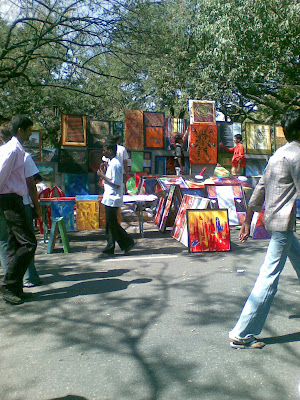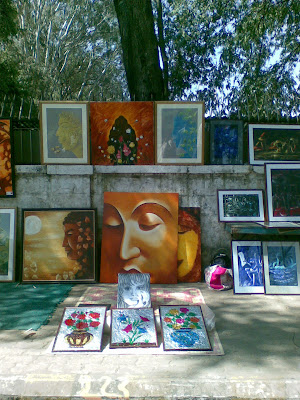N S Harsha, an artist who lives and works in Mysore has firmly imprinted the city on the global map. At the Christie’s auction of Asian contemporary art held in Hong Kong last month, Harsha’s painting ‘Mass Marriage’ went for a hammer price of HK$ 6.4 million, the highest among the Indian works. Harsha is currently busy completing his painting for the third Artes Mundi Prize, a prestigious award, for which he has been nominated along with seven other artists from all over the world. His entry called ‘Come give us a speech’ is a metaphorical painting that he is still working on. Art consultant Nalini S Malaviya catches up with him, to find out more about his art and community projects.
 You have set a record of sorts at the recent Christie’s Hong Kong auction. How does it feel?
You have set a record of sorts at the recent Christie’s Hong Kong auction. How does it feel?
It feels strange to be pulled into such a situation that my painting managed to set a ’monetary record’ and I am answerable to it. Frankly, I was shocked. For me, the equation hasn’t changed at all. I sold this long ago and it feels different to see it again in its present context after such a long gap.
Will you get any financial benefit from the sale?
Actually, no. I sold it in 2003, so for me it ended there.
Where have you studied art?
I did my BFA in CAVA in Mysore then MFA in Faculty of Fine arts in Baroda.
How difficult has it been for you to establish yourself?
For me the artistic journey is not a career. I never worked with an intention to establish myself in the art world. It has always been a deeply-rooted personal activity for me. My struggle was more about believing in myself and realising or executing these thoughts. The best thing a small town can offer is ’personal time and space’ which I feel gets a little compromised in a big city. So I do try and balance between my travels abroad and my time here in Mysore.
Along with art, you are also involved with a lot of community projects. Tell us more about that.
I have worked on community art projects for the last 10 years in several different countries. It has been a rich learning process for me. It has enriched my understanding of different cultural practices as well as the new challenges we are facing as a global community. I focus on bringing many different voices and expressions on a single platform to understand the complexity of our times. Every workshop is designed according to the context and place where it is held, so I do a lot of homework before designing the project. This also gives me the freedom to work in public spaces along with conventional gallery and museum spaces.
What is the future of art as an investment avenue?
Oh! I don’t have any knowledge in this field. For me, collecting art is about collecting a ’thought’. So it is best if this is answered by an investment banker.
(Published in Mysore Plus)
 You have set a record of sorts at the recent Christie’s Hong Kong auction. How does it feel?
You have set a record of sorts at the recent Christie’s Hong Kong auction. How does it feel? It feels strange to be pulled into such a situation that my painting managed to set a ’monetary record’ and I am answerable to it. Frankly, I was shocked. For me, the equation hasn’t changed at all. I sold this long ago and it feels different to see it again in its present context after such a long gap.
Will you get any financial benefit from the sale?
Actually, no. I sold it in 2003, so for me it ended there.
Where have you studied art?
I did my BFA in CAVA in Mysore then MFA in Faculty of Fine arts in Baroda.
How difficult has it been for you to establish yourself?
For me the artistic journey is not a career. I never worked with an intention to establish myself in the art world. It has always been a deeply-rooted personal activity for me. My struggle was more about believing in myself and realising or executing these thoughts. The best thing a small town can offer is ’personal time and space’ which I feel gets a little compromised in a big city. So I do try and balance between my travels abroad and my time here in Mysore.
Along with art, you are also involved with a lot of community projects. Tell us more about that.
I have worked on community art projects for the last 10 years in several different countries. It has been a rich learning process for me. It has enriched my understanding of different cultural practices as well as the new challenges we are facing as a global community. I focus on bringing many different voices and expressions on a single platform to understand the complexity of our times. Every workshop is designed according to the context and place where it is held, so I do a lot of homework before designing the project. This also gives me the freedom to work in public spaces along with conventional gallery and museum spaces.
What is the future of art as an investment avenue?
Oh! I don’t have any knowledge in this field. For me, collecting art is about collecting a ’thought’. So it is best if this is answered by an investment banker.
(Published in Mysore Plus)








 On the other hand, Indian artists who have struggled a lot in their career and have only now begun to make a mark at international auctions are unfortunately not getting any share of the proceeds. We have seen in the past that legends from the fields of music and sports have languished in abject poverty in their last days. One wonders, when the modern and contemporary Indian art market is thriving so well, is there a way to acknowledge the contribution of its key players? Giving a royalty to the artist may or may not be the answer, but a solution that aims at long term benefits rather than short-term gain is much needed.
On the other hand, Indian artists who have struggled a lot in their career and have only now begun to make a mark at international auctions are unfortunately not getting any share of the proceeds. We have seen in the past that legends from the fields of music and sports have languished in abject poverty in their last days. One wonders, when the modern and contemporary Indian art market is thriving so well, is there a way to acknowledge the contribution of its key players? Giving a royalty to the artist may or may not be the answer, but a solution that aims at long term benefits rather than short-term gain is much needed.
